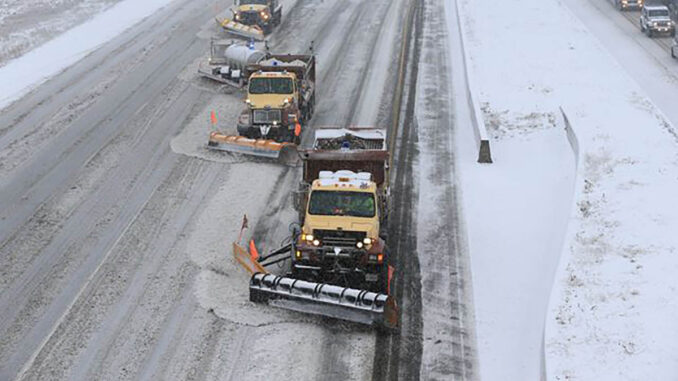
With winter weather on the way, the City of Toronto’s winter maintenance crews are prepared to respond to snowfall and slippery conditions all season long to help keep everyone moving safely.
Today, Deputy Mayor Jennifer McKelvie (Scarborough-Rouge Park) and Barbara Gray, General Manager of Transportation Services outlined the City’s winter weather readiness plans for clearing and de-icing roads, sidewalks and bikeways and for responding to watermain breaks.
The budget for winter maintenance is more than $100 million (subject to Toronto City Council approval) and will be used to clear snow and ice from:
• 14,700 lane kilometres of roads and on-street bike lanes
• 7,900 kilometres of sidewalks
• 956 kilometres of cycle tracks (separated bike lanes) and multi-use trails.
The City’s snow and ice response plan prioritizes safety and mobility for all residents and particularly for emergency and transit vehicles. A fleet of more than 1,400 pieces of snow clearing equipment is ready to quickly mobilize 24 hours a day, seven days a week, when the weather changes.
The application of road salt is the first line of defence when winter weather arrives. Plowing begins when the snow is this deep:
• 2.5 centimetres – expressways
• five centimetres – major roads and transit routes
• eight centimetres – residential streets.
The amount of time it takes to clear snow and ice depends on the weather, infrastructure type and location. Specific details about clearing timelines and service levels is available on the City’s website: www.toronto.ca/snow.
Residents can track the location of plows and salt trucks and find out which streets have been recently cleared on the PlowTO map: www.toronto.ca/PlowTO.
A Winter Road Operations Fact Sheet is available on the City’s website: www.toronto.ca/news/city-of-to
Residents also have an important role to play in keeping streets safe during the winter. Property owners are responsible for clearing public sidewalks adjacent to their property within 12 hours of the end of snowfall when less than two centimetres of snow accumulates. Clearing private property, such as driveways, parking spaces, steps and ramps, within 24 hours of the end of snowfall is also important and provides safe access to people and vehicles. Tips on how to shovel snow safely are available on the City’s Snow Shovelling webpage: www.toronto.ca/community-peopl
Beyond snow clearing, residents can take the following actions to increase their safety and the safety of others this winter:
• Plan for extra time when travelling
• Take public transit where possible and drive according to road and weather conditions
• Keep a safe distance from snow clearing equipment and other vehicles
• Remove snow and ice from vehicles and install winter tires for better traction
• Wear warm clothing and appropriate footwear to avoid slips and falls
• Keep pets indoors during extreme weather conditions.
City staff are monitoring underground infrastructure because cold weather and rapid swings between thaw and freezing temperatures can cause an increase in watermain breaks. There is an average of 700 watermain breaks annually – many occurring between November and March. City crews fix watermain breaks and restore water as quickly as possible. The number of watermain breaks has steadily declined in the past decade, as a direct result of capital investment in replacement and rehabilitation of the pipes. More information about watermains is available on the City’s Watermains webpage: www.toronto.ca/watermains.
Cold weather can also cause pipes inside the home and on private property to freeze, which can lead to no water or burst pipes. Residents are reminded to:
• Prepare pipes for winter by wrapping foam pipe insulation around pipes prone to freezing, especially near outside walls and in crawl spaces, attics and garages
• Seal air leaks around windows and doors
• Disconnect outdoor hoses and drain and shut the outdoor water supply.
More tips can be found on the City’s Prevent or Thaw Frozen Pipes webpage: www.toronto.ca/frozenpipes.
Quotes:
“Going into this winter season, I want to assure you that safety is our number one priority. The City of Toronto is prepared for the winter weather that is on the way. It takes time to clear snow and ice from our streets. Please be patient, lend a hand to your neighbours and give winter maintenance crews space to do their critical work.”
– Deputy Mayor Jennifer McKelvie (Scarborough-Rouge Park), Chair of the Infrastructure and Environment Committee
“It is our priority to keep everyone moving safely in the manner that they choose this winter. While the amount of time it takes to clear snow and ice changes depending on the weather, you can trust that our crews will respond as soon as it starts to snow and will continue to clear roads, sidewalks and bikeways 24 hours a day, seven days a week until they are clear. We have the right equipment and staff to meet Toronto’s snow clearing service levels to get the job done.”
– Barbara Gray, General Manager, Transportation Services
SOURCE City of Toronto

Leave a Reply